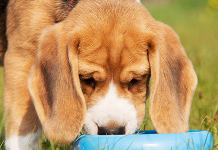When is a Pocket Beagle Full Grown?
The term “Pocket Beagle” is sometimes used to refer to a smaller version of the Beagle breed. However, it’s essential to note that there is no official breed recognized as a separate “Pocket Beagle” by major kennel clubs like the American Kennel Club (AKC) or the Kennel Club (UK).

The typical Beagle breed is known to reach its full physical size and maturity around 1 to 1.5 years of age. At this point, they are considered fully grown. However, individual dogs may continue to develop mentally and behaviorally beyond this age.
If you are considering getting a smaller-sized Beagle, be cautious about breeders who claim to have “Pocket Beagles” as there may be unscrupulous practices or potential health issues associated with breeding for extreme small size. Always make sure to research and find reputable breeders who prioritize the health and well-being of their dogs.
If you’re interested in a smaller Beagle, you can inquire about the size of the Beagle’s parents and their lineage to get an idea of how big the puppy is likely to be when fully grown. However, keep in mind that predicting an exact size for any individual dog can be challenging, as genetics can be complex and result in a range of sizes even within the same litter.
What Impacts the Size of a Pocket Beagle?
The size of a “Pocket Beagle” or any Beagle, for that matter, can be influenced by various factors, including:
Genetics: The most significant factor influencing a dog’s size is its genetics. The size of the parents and their lineage will play a crucial role in determining how big or small the offspring will be. If both parents are smaller in size, there is a higher chance of producing smaller puppies.
Breeding Practices: Some breeders may intentionally select smaller Beagles to produce smaller-sized offspring, often marketed as “Pocket Beagles.” However, it’s essential to be cautious about such practices, as breeding for extreme sizes can lead to health issues and genetic abnormalities.
Nutrition: Proper nutrition during a dog’s formative stages is crucial for healthy growth. A well-balanced diet with appropriate amounts of proteins, fats, and other essential nutrients will support a Beagle’s development and ensure they reach their potential size.
Health and Medical Conditions: Certain health conditions or medical issues can impact a dog’s growth and development. If a Beagle has health problems during its formative months, it may affect its overall size and development.
Exercise: Regular exercise is essential for a dog’s overall health and development. Appropriate exercise can help maintain a healthy weight and muscle tone, which may impact a Beagle’s size.
Environmental Factors: The environment in which a dog is raised can also play a role in its development. Stress, living conditions, and socialization can affect a dog’s overall well-being and, consequently, its growth.
Neutering/Spaying: Studies suggest that early neutering or spaying of dogs may affect their growth and can lead to slightly larger sizes due to hormonal changes.
It’s crucial to remember that responsible breeders prioritize the health and well-being of their dogs over extreme size or appearance. If you are considering getting a Beagle or any dog, it’s essential to choose a reputable breeder who follows ethical breeding practices and cares for the health of their dogs. Additionally, adopting from shelters or rescues is another option to provide a loving home for a Beagle in need.
How Big Do Pocket Beagles Get?
As mentioned earlier, the term “Pocket Beagle” is not an officially recognized breed or size category by major kennel clubs like the American Kennel Club (AKC) or the Kennel Club (UK). It is often used informally to refer to smaller versions of the Beagle breed. However, there is no specific standard size for a “Pocket Beagle” because it is not a standardized breed.
The typical Beagle breed, according to AKC standards, is a small to medium-sized hound with an average height of about 13 to 15 inches (33 to 38 cm) at the shoulder and weighing between 20 to 30 pounds (9 to 13.6 kg).
If someone is marketing a dog as a “Pocket Beagle” or claiming to have a specific size category of Beagles called “Pocket Beagles,” it’s essential to be cautious. As mentioned before, breeding for extreme sizes can lead to health issues and genetic abnormalities.
If you are interested in a smaller-sized Beagle, you can inquire about the size of the Beagle’s parents and their lineage when talking to reputable breeders. However, keep in mind that predicting the exact size of an individual dog can be challenging due to genetic variations and the influence of other factors on growth.
When Do Pocket Beagles Stop Growing?
Since there is no official size category or breed known as “Pocket Beagle,” we can refer to the typical Beagle breed’s growth pattern. Beagles, like most dog breeds, reach their full physical size and maturity around 1 to 1.5 years of age. By this age, they are considered fully grown.
It’s important to note that while Beagles generally stop growing in terms of physical size around 1 to 1.5 years, their mental and behavioral development may continue beyond this age. Training and socialization play crucial roles during their formative months to ensure they develop into well-behaved and well-adjusted adult dogs.
As with any dog, individual variations may occur, and some Beagles might continue to fill out and develop muscle tone even after they have reached their full height. However, the most significant growth in terms of height and overall size is typically complete by the time they reach 1.5 years of age.
When Do Pocket Beagles Calm Down?
The term “Pocket Beagle” is not an officially recognized breed or size category, so we can refer to the typical Beagle breed’s behavior. Beagles, like many other dog breeds, tend to be quite energetic and playful, especially in their puppy and adolescent stages. As they mature, they generally start to calm down, but the timing can vary from one dog to another.
Beagle puppies can be especially rambunctious and full of energy, and they might display hyperactive behavior until they reach around 1 to 2 years of age. During this time, it’s crucial to provide them with regular exercise, mental stimulation, and training to help channel their energy in positive ways and establish good behavior habits.
Around 2 to 3 years of age, Beagles often start to show signs of maturity, and their energy levels may begin to decrease. They usually become more settled and less hyperactive. However, it’s essential to remember that Beagles, like many breeds, retain their playful and curious nature throughout their lives. Even as adults, they may enjoy playtime and activities that keep them engaged and entertained.
To help your Beagle calm down and develop good behavior, consistent training and socialization from an early age are essential. Also, providing regular exercise, mental stimulation, and opportunities for play can help them stay happy and content. Each dog is unique, so their individual temperament and behavior may vary. Understanding and meeting their needs will go a long way in ensuring they become well-adjusted and well-behaved companions.
Do Males and Females Grow the Same Size?
In general, male and female Beagles (or Beagles in most dog breeds) can have slight differences in size and weight, but the variations are often not significant. The sexual dimorphism (physical differences between males and females) in Beagles is relatively minimal compared to some other breeds.
Here are some general observations regarding the size of male and female Beagles:
- Height: On average, male Beagles may be slightly larger in height compared to females, but the difference is typically only a few centimeters (1-2 inches).
- Weight: Again, male Beagles might weigh a bit more on average than females, but the difference is generally not substantial. The weight difference could be around a few pounds (1-3 pounds).
It’s essential to remember that individual variations occur in every breed, and not all males will be larger than females. There can be large females and small males as well. Genetics and lineage play significant roles in determining the size of any individual dog.
If size is a crucial factor for you, it’s best to discuss your preferences with reputable breeders or rescue organizations when considering adopting a Beagle. They can provide insights into the size of the Beagle’s parents and their lineage, which can give you a rough idea of how big the puppy is likely to grow. However, predicting the exact size of any individual dog is challenging due to genetic variations and other factors.
How To Measure the size of a Pocket Beagle?
As previously mentioned, there is no official size category or breed recognized as “Pocket Beagle” by major kennel clubs. However, if you have a smaller-sized Beagle and want to measure its size, you can follow these general steps:
Height Measurement: To measure the height of a Beagle, place the dog on a flat surface with all four paws standing naturally. Use a measuring tape or a ruler and measure from the ground to the highest point of the shoulders (the withers). Make sure the dog is standing still and not slouching or stretching.
Length Measurement: To measure the length of a Beagle, have the dog stand up straight. Measure from the base of the neck (where the collar would sit) to the base of the tail. Ensure the measuring tape is following the natural curve of the dog’s back.
Weight Measurement: To measure the weight of a Beagle, you can use a digital scale. Place the dog gently on the scale and make sure the dog’s weight is evenly distributed on all four paws.
Girth Measurement: To measure the girth (the circumference around the chest just behind the front legs) of a Beagle, use a flexible measuring tape and wrap it around the chest area. Make sure it’s snug but not too tight.
It’s essential to note that these measurements will give you a general idea of the dog’s size, but they may not accurately represent the dog’s full-grown size or how it compares to other Beagles. If you are concerned about the size of your Beagle or its growth, consult with a veterinarian who can assess the dog’s health and development and provide appropriate guidance.
Pocket Beagle Life Expectancy
Since there is no officially recognized breed or size category called “Pocket Beagle,” we can refer to the typical life expectancy of Beagles in general. Beagles are generally considered a relatively healthy breed, and their life expectancy is usually between 12 to 15 years.
Proper care, regular exercise, a balanced diet, and regular veterinary check-ups can contribute to a Beagle’s overall health and longevity. However, as with any dog, individual health and genetics play a significant role in determining their specific life span.
To ensure your Beagle lives a healthy and happy life, provide them with regular exercise, mental stimulation, proper nutrition, and regular veterinary care. Be sure to keep an eye out for any potential health issues and address them promptly with the guidance of a veterinarian. Early detection and treatment of health problems can make a significant difference in a dog’s quality of life and overall lifespan.
Fun Facts About Pocket Beagles
As mentioned earlier, the term “Pocket Beagle” is not an officially recognized breed or size category. It is often used informally to refer to smaller versions of the Beagle breed. However, since “Pocket Beagle” is not a standardized term, there are no specific fun facts related to this non-existent breed.
Instead, let me share some interesting and fun facts about Beagles, the breed that the term “Pocket Beagle” is often associated with:
Beagles are scent hounds and have an extraordinary sense of smell. They were originally bred for hunting rabbits and hare.
Snoopy, the famous character from Charles M. Schulz’s comic strip “Peanuts,” is a Beagle.
Beagles are known for their friendly and sociable nature. They are generally good with children and other pets.
The name “Beagle” is believed to have originated from the French word “be’geule,” which means “open throat” or “gaping mouth,” referencing the breed’s melodious howl.
Beagles are part of the Hound group and were first recognized by the American Kennel Club (AKC) in 1885.
Their ears are long and droopy, which helps sweep scents from the ground into their nose, enhancing their sense of smell.
Beagles are popular choices for scent detection work, including drug detection and search-and-rescue operations.
The Beagle Brigade, a team of Beagles, is employed at some airports to sniff out illegal food and agricultural products in passengers’ luggage.
Beagles can be quite food-motivated, which can be helpful during training but also means they may have a tendency to scavenge for food.
Beagles have been featured in various movies and TV shows, further contributing to their popularity and recognition.
Remember, regardless of the size or name variations, Beagles are wonderful and lovable dogs with unique characteristics that make them great companions for families and individuals alike.
Pocket Beagle Full Grown: Frequently Asked Questions
What is a Pocket Beagle?
A “Pocket Beagle” is an informal term used to describe smaller-sized Beagles. There is no official breed or size category recognized as “Pocket Beagle” by major kennel clubs.
How big do Pocket Beagles get?
As there is no standardized size for “Pocket Beagles,” their size can vary. Typically, Beagles reach an average height of 13 to 15 inches and weigh between 20 to 30 pounds.
When is a Pocket Beagle fully grown?
The typical Beagle breed reaches full physical size and maturity around 1 to 1.5 years of age.
Do Pocket Beagles have a different temperament?
There is no specific temperament associated with “Pocket Beagles” as it is not an official breed. Beagles, in general, are friendly, curious, and sociable dogs.
Can you guarantee a specific size for a Pocket Beagle puppy?
It is challenging to guarantee an exact size for any individual dog, as genetics and other factors influence their growth. Reputable breeders focus on the health and well-being of their dogs rather than producing extreme sizes.
How do I find a Pocket Beagle puppy?
If you are interested in a smaller Beagle, research and find reputable breeders who prioritize the health of their dogs. Alternatively, consider adopting from shelters or rescues to provide a loving home for a Beagle in need.
Are Pocket Beagles healthier than standard-sized Beagles?
The overall health of any dog, regardless of size, depends on various factors, including responsible breeding practices, nutrition, exercise, and regular veterinary care.
Are Pocket Beagles good family pets?
Beagles, including those of smaller sizes, are known to be friendly and good with children and other pets, making them excellent family companions.
Can Pocket Beagles be used for hunting?
Smaller-sized Beagles may not have the same hunting abilities as larger ones, but they may still have a keen sense of smell and enjoy scent-related activities.
Is it ethical to breed and sell Pocket Beagles?
Breeding for extreme sizes or marketing dogs as “Pocket Beagles” can be controversial and potentially harmful to the dogs’ health. Ethical breeders prioritize the well-being of their dogs over extreme size or appearance.
Conclusion
In conclusion, the term “Pocket Beagle” is not an officially recognized breed or size category by major kennel clubs. It is often used informally to refer to smaller versions of the Beagle breed. However, there is no specific standard or guarantee of size for “Pocket Beagles.”
The typical Beagle breed reaches its full physical size and maturity around 1 to 1.5 years of age, and their height ranges from 13 to 15 inches, with a weight of 20 to 30 pounds on average.
If you are interested in a smaller-sized Beagle, it’s essential to research and find reputable breeders who prioritize the health and well-being of their dogs over extreme size. Alternatively, consider adopting from shelters or rescues to provide a loving home for a Beagle in need.
Regardless of the size or name variations, Beagles are wonderful and lovable dogs with unique characteristics that make them great companions for families and individuals alike. Proper care, training, and socialization will ensure they grow into happy and well-behaved members of the family.






